Wetland birds of the Botanic Gardens
Step out onto the boardwalk and discover a different world between land and lagoon.
Birds that have adapted to the Eulamere Wetlands thrive here – can you see how they live in this floating world of water weeds and sedges?
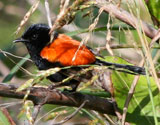
Red-backed Fairy-wren
Malurus melanocephalus - 10 to 13cm in size
The male in breeding plumage has a black head and body with striking red back and brown wings. At other times it has a brown upper body and white underparts. The female always has a brown body and a yellowish spot under the eye. They communicate with one another whilst foraging, with a soft "ssst".
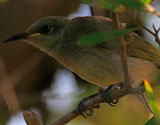
Brown Honeyeater
Lichmera indistincta - 12 to 16cm in size
They are pale grey-brown birds with a distinctive yellow tuft behind their eye and they have highly developed brush-tipped tongues for nectar feeding. Their clear rolling musical call is very loud for their size. Their small, neat cup-nest is made from fine bark, grasses and plant down, bound with spider’s web and slung by the rim in a shrub, fern or tree.
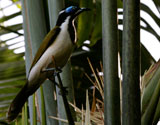
Blue-faced Honeyeater
Entomyzon cyanotis - 25 to 31cm in size
Their feathers are distinctive, with olive upper parts, white underparts and a black head and throat. Adults have a blue area of bare skin around the eye, whilst juveniles have yellow or green patches of skin. Usually very inquisitive and friendly birds, they often search for fruit, insects and sweet things.
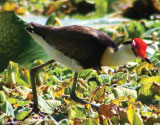
Comb-crested Jacana
Irediparra gallinacea - 20 to 27 cm in size
The Jacana’s long toes spread it’s weight over floating water-lily pads, where it hunts aquatic insects. They appear to be walking on water and are often named the ‘Jesus bird’. Jacanas trail their long legs and feet behind and angle them accordingly to assist with steering their flight.
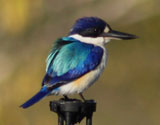
Forest Kingfisher
Todiramphus macleayii - 17 to 23 cm in size
A flash of blue is usually all you will see of these birds as they suddenly swoop down and pounce on an insect or small lizard. You may see them perched on low bare branches and posts studying their surroundings. Look for birds with a dark royal blue head and pale turquoise feathers on their back with a large white spot over the bill.
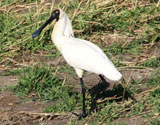
Royal Spoonbill
Platalea regia - 75 to 80cm in size
These large white water-birds get their name from their unusual straight black bill with a spoon-shaped end. They’re often seen wading in shallow waters, sweeping sideways with their bill to feed on shrimps, crustaceans and other aquatic insects.
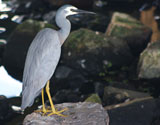
White-faced Heron
Egretta novaehollandiae - 66 to 69cm in size
White-faced Herons are slightly bluish-grey, relatively small herons, with yellow legs and white facial markings. Their flight is slow and bouncing and they typically perch on fence-posts, trees and poles. Their common call is a gravelly croak or gobble, usually during flight.
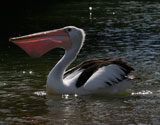
Australian Pelican
Pelecanus conspicillatus - 1.6 to 1.8m in size
It has often been said that the bill of a pelican can hold more than it’s belly can. Pelicans plunge their bills into the water, using the pouch as a net. Once something is caught, a pelican brings it’s pouch to it’s chest to empty the water and then manoeuvres the prey into a swallowing position. Pelicans often work in groups to drive fish to shallower water.
For more information download the birds of the lagoon factsheet

